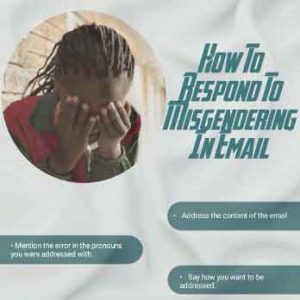While pronouns do not seem to be a big deal to many people, It is quite important to some, especially to a transgender.
Many of them try to change the gender they were born with and have to convince the people around them that they can choose whichever they want.
Maybe everyone has the right to choose the gender he or she wants. Whether you are transgender or not, this article is here to guide you on how to correct a person who has addressed you with the wrong pronoun without sounding rude.
Did you know a lady can be addressed with a male pronoun just to insinuate she’s not attractive enough? How would you respond in that case? Keep reading.
6 Step-By-Step Process to Correct Someone About Your Gender in an Email

- Step 1 – Show appreciation for the email.
- Step 2 – Address the content of the email
- Step 3 – Mention the error in the pronouns you were addressed with.
- Step 4 – Say how you want to be addressed.
- Step 5 – Address the content of the email again.
- Step 6 – Conclude with polite salutations
Step 1: Show appreciation for the email
When you receive an email, you are not meant to find faults in the words used unless they affect the message being passed in the content.
However, some people care about how they are addressed so much. Also, if the email is coming from a person you will be working with for a long time, you may want to make sure they know your gender.
Even though the purpose of responding to the email is to make corrections about your assumed gender, you have to do it formally.
You should start with a polite greeting that appreciates the email. Just thank the person for informing you or taking the time to pass a message to you.
Whatever reason you have for replying may come next but appreciation should come first. Whatever complaints you address after will not seem rude or angry due to the warmth in your introduction.
Step 2: Address the content of the email
If an email requires that you respond, you should respond with the main message you want to pass before addressing any irrelevant thing.
A complaint about the pronoun you were addressed with will be tagged irrelevant, even though you are respected and will not be challenged for it.
Give your response to the email. When you are done passing the important message, you can address the mistake in how you were addressed.
If the email did not require a response, you can simply say you read the email and agree with whatever was said there. You may say you like the idea.
You may say you have noted the information that was shared with you. This shows you have respected the content of the email.
Step 3: Mention the error in the pronouns you were addressed with.
You have to consider that typographical errors can happen. It may also be an absentminded mistake.
Instead of going straight to the point about your gender and how you like to be addressed, you can politely point out that the person addressed you with he/she in the email.
You can state that the person did not bother to ask about your gender.
If both pronouns were used to address you, you wouldn’t have to respond so you can mention that you know it was a mistake and state why you bothered to mention it.
You may say you only mentioned it because you feel uncomfortable when you are addressed with the wrong pronoun.
Step 4: State how you would like to be addressed
You can address why you think the mistake was made and say your gender or the pronoun you want to be addressed with.
You can mention that you are a female despite your name which suggests otherwise. You may say you are transgender and you should be addressed as a male.
You can just state the pronouns you want to be called without going on and on about it.
Step 5: Address the content of the email again
If the email required a special response, you can slowly go back to addressing the main content of the email. You should do a summary of it since you addressed it earlier in the email.
Step 6: Conclude with polite salutations
You can say thanks again for the email and add polite salutations.
4 Reasons Why Are You Addressed With The Wrong Pronoun?

Are you a woman who is often addressed with a male pronoun? Or a man who is often addressed with a female pronoun?
It is probably enough to get some people angry but it shouldn’t be. At least, it shouldn’t always be a reason to fly off the handle.
There are several reasons a person may address you with the wrong pronoun. Below are four of these possible reasons;
- You have a name for the opposite gender.
- You look like the opposite gender.
- It’s a mistake
- Assumption of gender on social media
You have a name for the opposite gender
Before you get angry about being addressed with the wrong pronoun, you may want to consider the reason for it.
If you are transgender, it may be your fault that you are not being addressed with the gender you chose for yourself.
Usually, a transgender would change his or her name to that of the opposite gender. Choosing a female name can make people address you with female pronouns.
Choosing a male name will make people address you with male pronouns.
You don’t have to be transgender before this mistake can be made. If the name you were given at birth is that of the opposite gender, people can make the mistake of addressing you as the opposite gender.
However, this should not happen if the person is right in front of you. This is more likely to happen in a phone conversation.
Since the person cannot see you, your name can make the person assume your gender. If your name is used by both genders, this mistake can also be made.
You look like the opposite gender
When you are addressed with the wrong pronoun in a text message or email, you should understand that the person cannot see you unless there is an indication that you are a sir or a ma.
However, this does not make it impossible to be called by the wrong pronoun when a person is staring right into your face.
If you look like a man, you may be called with a male pronoun. The same may happen if you look like a female.
Your hairstyle may be your mistake. It could be your make-up or the unis*x dress you chose to put on. This may also be used as an insult. A person may intentionally use the wrong pronoun for you as an insult.
If a man acts like a female, he can be addressed with the female pronoun to suggest that he is not man enough.
A female may also be addressed with the male pronoun to suggest that she does not look good enough to be a female.
Also, if you are a transgender being addressed with the pronoun you stopped using, it is probably your fault. You may have to put extra work into looking like the gender you chose for yourself.
It’s a mistake
A person may be standing in front of you and address you with the wrong pronoun. There may be no particular reason.
If you are not a transgender with a unis*x name and you don’t look like the opposite gender, then it may be a simple mistake.
You don’t even have to correct the person but you can if you want to. The person will simply apologize for the mistake and correct himself or herself.
Assumption of gender on social media
If you have been addressed as the wrong gender on social media more than once, this may be the issue. People often use different names or nicknames on social media.
These names can be used by different genders in different parts of the world so it may lead to the assumption of your gender.
Asides from the username on your profile, your display picture can make a person assume that you are the opposite gender.
If you post pictures of your partner often and use one of those pictures as your display picture, any person may think it is you, even if your profile clearly states your gender.
It may also be assumed based on what you post and how you comment under posts. You can simply correct the person about your gender.
You can also state your real name or post your real pictures so people don’t make the mistake.
10 Things to Say When You Are Addressed With The Wrong Pronoun

- I’m not a guy/girl
- I have the right to choose what I want to be addressed by.
- You could have asked about my gender
- I would rather you use She/he when referring to me.
- Do I look like a guy/girl?
- What makes you assume my gender?
- I am transgender
- Does my name suggest I’m a girl/guy?
- Why would you think I’m a girl/guy?
- My profile clearly states my gender
I’m not a guy/girl
Instead of throwing a tantrum because a person has called you with the wrong pronoun, you can tell the person you are not meant to be addressed with that pronoun. It’s as simple as that.
I have the right to choose what I want to be addressed by
You can tell this to the person if he/she stays adamant about addressing you with a particular pronoun.
You shouldn’t say this if the person is trying to frustrate you or insult you. Rather, you should ignore it.
You could have asked about my gender
You can say this if a person assumes your gender in a text, email, or on social media. By saying this to the person, the person may ask if he/she had guessed wrong, then you can answer.
I would rather you use She/he when referring to me.
A transgender may have to say this. The transition from female to male or vice versa can be time-consuming so you may find yourself looking like the [opposite] gender.
Do I look like a guy/girl?
When you are addressed as a guy instead of a girl, you can simply ask if you look like it. It may have been a mistake.
Before you ask this question, you should make sure you are not obviously appearing like a guy.
What makes you assume my gender?
This sounds dumb but a transgender is free to say this. You can only say this to someone who cannot see you and has no way of knowing your gender.
This suggests that the person should have asked about your gender instead of assuming.
I am transgender
When you change your gender, you don’t automatically start to look like the opposite gender. If you are addressed wrongly, for this reason, you can tell the person you are transgender.
That way, the person knows he/she has addressed you wrongly.
Does my name suggest I’m a girl/guy?
Ask this question if your name is mostly used by your gender. This implies that your name should make it obvious that your gender is the opposite.
You should only say this if the person is not in front of you. In that case, your look matters more than your name.
Why would you think I’m a girl/guy?
You can ask why a person has addressed you wrongly. This may give you the answer to why most people address you with the wrong pronoun.
When the person answers, you can tell him/her that you are the opposite gender.
My profile clearly states my gender
If you have been addressed wrongly on social media, you can respond with this unless it is a comment under a post and the person is not expected to check your profile for anything.
However, if it is a direct chat, you can say this.
7 Things to Say When You Address A Person With The Wrong Pronoun

- I am so sorry. The name misled me.
- I was absent-minded.
- I was wrongly informed.
- That was a typographical error.
- I just realized it.
- I forgot your preferred gender. Pardon me.
- I forgot to edit the template correctly
I am so sorry. The name misled me
You can use this excuse if the person has a unis*x name or a name for the opposite gender.
I was absent-minded
You can say this if you have no excuse. It is possible to make silly mistakes when you are absentminded, especially if you know the person well enough to not make such a mistake.
I was wrongly informed
If you are sending an email, you can use this excuse to suggest that someone misinformed you about the person’s gender.
That was a typographical error
If this happens on social media, you can use this excuse and you won’t be questioned.
Sorry. I just realized it.
This suggests that you were absent-minded when you made the mistake without realizing it.
I forgot your preferred gender. Pardon me
If the person is transgender, you should say this. It may sound a bit sarcastic though.
I forgot to edit the template correctly
This suggests that the email was already written and you only edited some things so you may have forgotten to correct the pronouns.